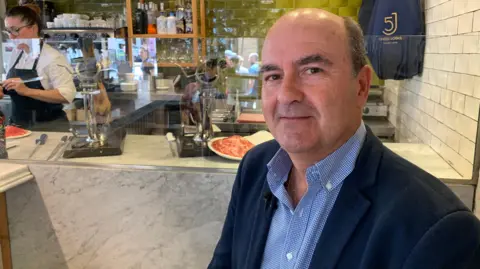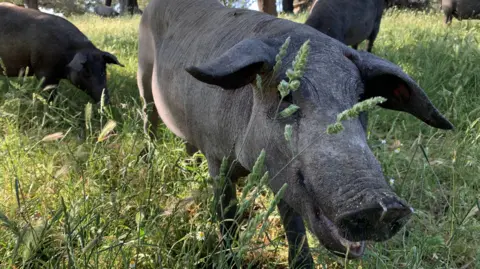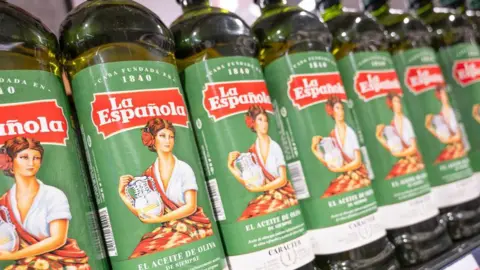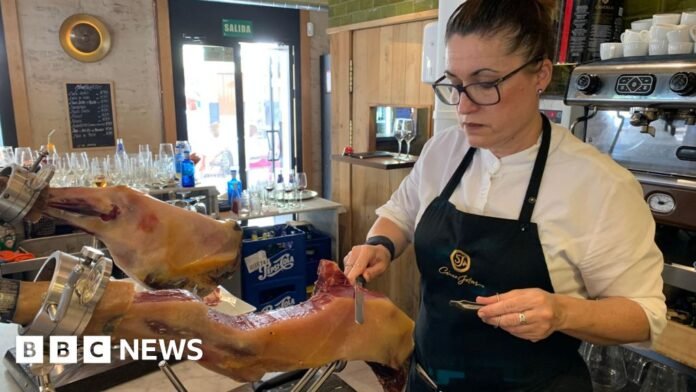Business reporter
 Guy Hedgecoe
Guy HedgecoeIt’s lunchtime in a bar in the southern Spanish city of Seville. The kitchen is humming with activity, and behind the bar a member of staff pours cold beer from a tap into a glass.
Nearby, another uses a carving knife to cut slices from a large leg of jamón ibérico, or Iberian ham, placing each one on a plate, to be served as an appetiser.
There are few more Spanish scenes. And there are few more Spanish products than jamón ibérico, whose unique salty flavour is renowned across the world, and part of a national cured ham industry worth nearly €750m ($850m; £630m) each year in exports.
As he watches the jamón being carved, Jaime Fernández, international commercial director for the Grupo Osborne, which produces wine, sherry and the renowned Cinco Jotas brand of ham, describes it as a “flagship” national foodstuff.
“It’s one of the most iconic gastronomic products from Spain,” he says, pointing out how the pigs used to make the ham are reared in the wild and fed on acorns. “It represents our tradition, our culture, our essence.”
But jamón ibérico, like products across Spain and the rest of Europe, is facing the threat of trade tariffs imposed by US President Donald Trump.
There was no tariff on Spanish ham exports to the US until April of this year, when a 20% charge on all European imports was suddenly introduced, dropping to 10% pending negotiations.
However, in May Trump unsettled European exporters again when he said that the tariff for all EU goods could rise as high as 50% if trade talks with Brussels do not come to a successful agreement. The current deadline for this is 9 July.
“The United States is one of our top, priority markets,” says Mr Fernández. “The uncertainty is there, and it complicates our medium-and long-term planning, investments and commercial development.”
The tariffs, he adds, “pose a threat to our industry.”
 Guy Hedgecoe
Guy HedgecoeSpain’s overall economy is in rude health. The IMF has forecast growth this year of 2.5% – much higher than the other main EU economies – and unemployment is at a 17-year low.
But the tariff issue comes as a blow for the country’s pork industry, which represents more than 400,000 direct and indirect jobs, and is Europe’s largest.
Demand for cured ham in the US has grown substantially in recent years, and it has become the biggest importer of Spanish ham outside the EU.
But the Spanish industry now faces the prospect of having to raise retail prices for US consumers and therefore losing competitivity to local products, or those not subject to the same tariffs.
Spain’s olive oil sector is in a similar quandary. The world’s biggest producer of olive oil, Spain had set its sights on the US as a burgeoning market whose growth was driven by growing awareness of the health benefits of the product.
Yet the the tariff turmoil comes just as Spanish producers and exporters have recovered from a drought that slashed harvests in the south of the country, and sent prices temporarily soaring.
The US represents half of world olive oil consumption outside the EU.
It is also the country whose imports of the foodstuff from Spain have grown the most in recent years, increasing from approximately 300,000 tonnes per year a decade ago to around 430,000 tonnes, says Rafael Pico Lapuente, director general of the Spanish association of olive oil exporters (ASOLIVA).
Much will depend, he says, on the final tariff set for the EU.
“If there is a 10% tariff which is permanent, without differentiating between countries of origin, it’s not going to create a distortion on the international market,” says Mr Pico Lapuente.
He explains that American consumers might have to absorb the extra cost. And although local US producers of olive oil or similar products would gain a competitive edge, their output is small enough for it not to concern the likes of Spain.
However, he says it would be “a different story” if Trump introduced higher tariffs for the EU than for competitor olive oil countries outside the bloc – such as Turkey, the world’s second-largest producer, or Tunisia, an emerging grower. That scenario, he says, would have a major impact on the world market and Spanish producers.
 Guy Hedgecoe
Guy HedgecoeBut variations in tariffs between countries or trade blocs would also lead to a certain amount rule-bending and even chaos, according to Javier Díaz-Giménez, a professor of economics at the IESE business school in Madrid. He suggests two of Spain’s direct neighbours as a hypothetical example.
“If Spain has a 20% tariff and Morocco and Andorra have a 10% tariff, all the Spanish products that can go through Morocco or Andorra… will do so.”
He adds: “They will be first exported to Morocco and Andorra and from there re-exported to the United States with a 10% tariff.
“And it’s going to be really hard to make sure that these olives came from Andorra proper and not from Spain. Is Trump going to do something about that?”
 Getty Images
Getty ImagesFor now, Spanish producers and exporters must hold their breath as EU negotiations take place with Washington. For Mr Pico Lapuente, a big cause of concern is the influence – or as he sees it, lack of influence – his sector wields within the European trade bloc.
“The negotiations representing the EU’s 27 countries are carried out by Brussels,” he says. “In these negotiations, industrial products have a much bigger influence than food.
“I wouldn’t like it if, in this negotiation, food products like olive oil were used as mere bargaining chips in order to get a better deal for Europe’s industrial products. That worries me. And I hope it doesn’t happen.”
A spokesperson for the European Commission told the BBC that in negotiations with the US it will act “in defence of European interests, protecting its workers, consumers and its industries”.
Jaime Fernández, of the Grupo Osborne, believes his industry could live with the 10% tariff that is currently in place without suffering too much fallout.
However, a 20% charge, he says would cause the industry “to reconsider how to accelerate growth in some other markets, which would eventually lead to the relocation of resources from the US”.
He says his company is already looking at alternative markets in which to invest, such as China, or proven European ham consumers such as France, Italy and Portugal.
Mr Díaz-Giménez says that is the logical response to the current uncertainty.
“If I was the CEO of any company with a high exposure to the United States… I would have sent my entire sales team to find other markets,” he says.
“And by now, they would have found them. There would be plan Bs and plan Cs, to make sure that we have reduced this exposure to the US.”






